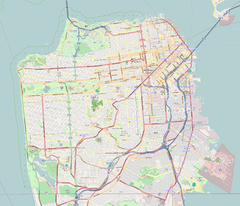Japanese tea garden at Golden Gate Park
| Japanese Tea Garden | |
|---|---|

Japanese Tea Garden
|
|
| Type | Public |
| Location | San Francisco, California, United States |
| Nearest city | San Francisco |
| Coordinates | 37°46′12″N 122°28′13″W / 37.770122°N 122.470231°WCoordinates: 37°46′12″N 122°28′13″W / 37.770122°N 122.470231°W |
| Area | 5 acres (2.0 ha) |
| Created | 1894 by Makoto Hagiwara |
| Status | Open year round |
| Website | japaneseteagardensf.com |
The Japanese Tea Garden in San Francisco, California, is a popular feature of Golden Gate Park, originally built as part of a sprawling World's Fair, the California Midwinter International Exposition of 1894. Though many of its attractions are still a part of the garden today, there have been changes throughout the history of the garden that have shaped it into what it is today.
The oldest public Japanese garden in the United States, this complex of many paths, ponds and a teahouse features plants and trees pruned and arranged in a Japanese style. The garden's 3 acres contain sculptures and structures influenced by Buddhist and Shinto religious beliefs, as well as many elements of water and rocks to create a calming landscape designed to slow people down.
After the conclusion of the 1894 World's Fair, Makoto Hagiwara, a Japanese immigrant and gardener, approached John McLaren with the idea to convert the temporary exhibit into a permanent park. Hagiwara personally oversaw the building of the Japanese Tea Garden and was official caretaker of the garden from 1895 to 1925. He specifically requested that one thousand flowering cherry trees be imported from Japan, as well as other native plants, birds, and the now famous koi fish, expanding the garden by four acres. After San Francisco's 1915 Panama-Pacific International Exposition closed, he obtained the two large ornamental wooden gates, and probably also the Tea Garden's prominent five-tiered pagoda, from that fair's Japanese enclave.
Following Makoto Hagiwara's death in 1925 his daughter, Takano Hagiwara, and her children became the proprietors and maintainers of the garden. With the onset of World War II in America and rising anti Japanese sentiment, Takano Hagiwara was evicted from the family's home and sentenced to an internment camp. Despite John McLaren's agreement with Hagiwara, the displacement of his family disrupted their stay at a promised century long home and the family was not allowed back or reimbursed after the war ended. In the period of their absence, the garden was renamed "The Oriental Tea Garden," and any structure expressing Japanese sentiment was demolished, including the Hagiwara home, and the original Shinto Shrine. Japanese tea servers were replaced with Chinese women in their traditional dress.
...
Wikipedia

